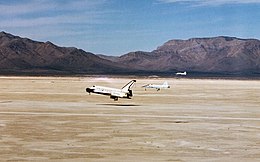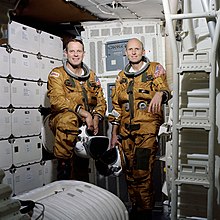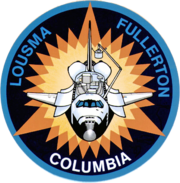STS-3

STS-3 landing at Northrop Strip, White Sands, New Mexico, on 30 March 1982, with two T-38 Talon chase planes observing.
|
|
| Mission type | Test flight |
|---|---|
| Operator | NASA |
| COSPAR ID | 1982-022A |
| SATCAT № | 13106 |
| Mission duration | 8 days, 4 minutes, 46 seconds |
| Distance travelled | 5,300,000 kilometres (3,300,000 mi) |
| Orbits completed | 130 |
| Spacecraft properties | |
| Spacecraft | Space Shuttle Columbia |
| Launch mass | 106,782 kilograms (235,414 lb) |
| Landing mass | 93,924 kilograms (207,067 lb) |
| Payload mass | 10,301 kilograms (22,710 lb) |
| Crew | |
| Crew size | 2 |
| Members |
Jack R. Lousma C. Gordon Fullerton |
| Start of mission | |
| Launch date | 22 March 1982, 16:00:00 UTC |
| Launch site | Kennedy LC-39A |
| End of mission | |
| Landing date | 30 March 1982, 16:04:46 UTC |
| Landing site | White Sands Runway 17 |
| Orbital parameters | |
| Reference system | Geocentric |
| Regime | Low Earth |
| Perigee | 241 kilometres (150 mi) |
| Apogee | 249 kilometres (155 mi) |
| Inclination | 38.0 degrees |
| Period | 89.4 minutes |
 Lousma (left) and Fullerton |
|
STS-3 was NASA's third Space Shuttle mission, and was the third mission for the Space Shuttle Columbia. It launched on 22 March 1982, and landed eight days later on 30 March. The mission involved extensive orbital endurance testing of the Columbia itself, as well as numerous scientific experiments. STS-3 was the first shuttle launch with an unpainted external tank, and the only mission to land at the White Sands Space Harbor near Las Cruces, New Mexico. The shuttle was forced to land at White Sands due to flooding at its originally planned landing site, Edwards Air Force Base.
Commander Jack Lousma previously flew as Pilot of the second Skylab crew, staying aboard the space station for 59 days from July to September 1973. Lousma had previously been selected in 1978 as Pilot for STS-2, which was then scheduled as a Skylab reboost mission. When delays in the Shuttle's development prevented Columbia from being launched in time to rendezvous with Skylab in 1979, STS-2 Commander Fred Haise retired from NASA and Lousma was then moved up as Commander of STS-3. Lousma also served on the support crews for Apollo 9, 10 and 13; he was the capsule communicator during the time of the latter mission's near-disastrous accident. He was also selected as backup Docking Module Pilot for the Apollo-Soyuz Test Project in 1975.
...
Wikipedia

